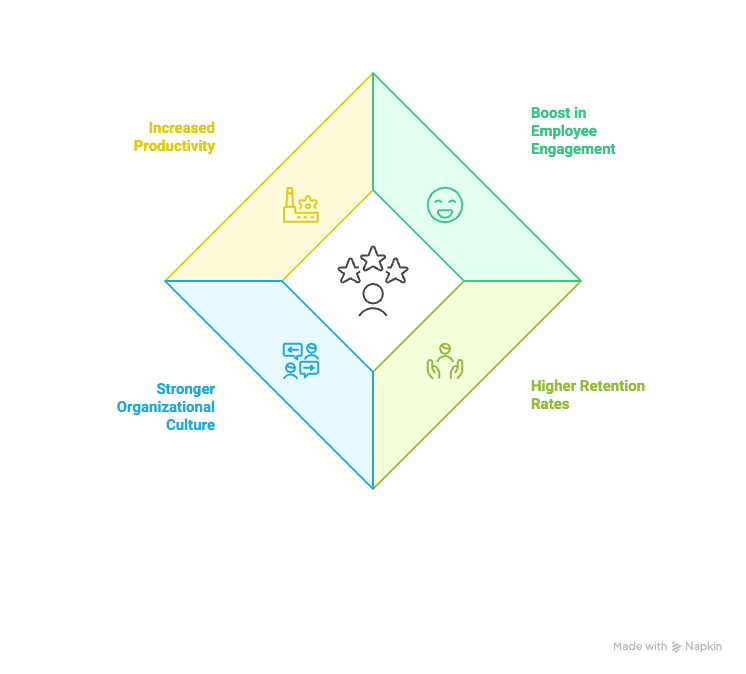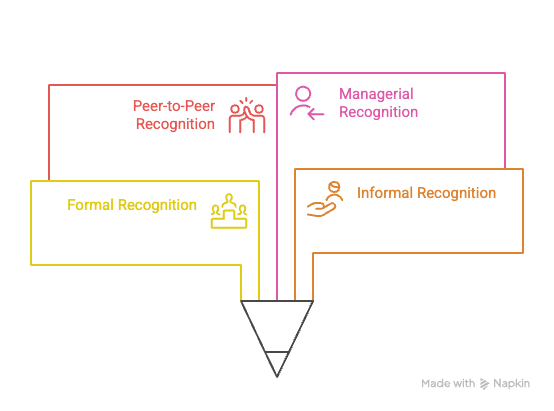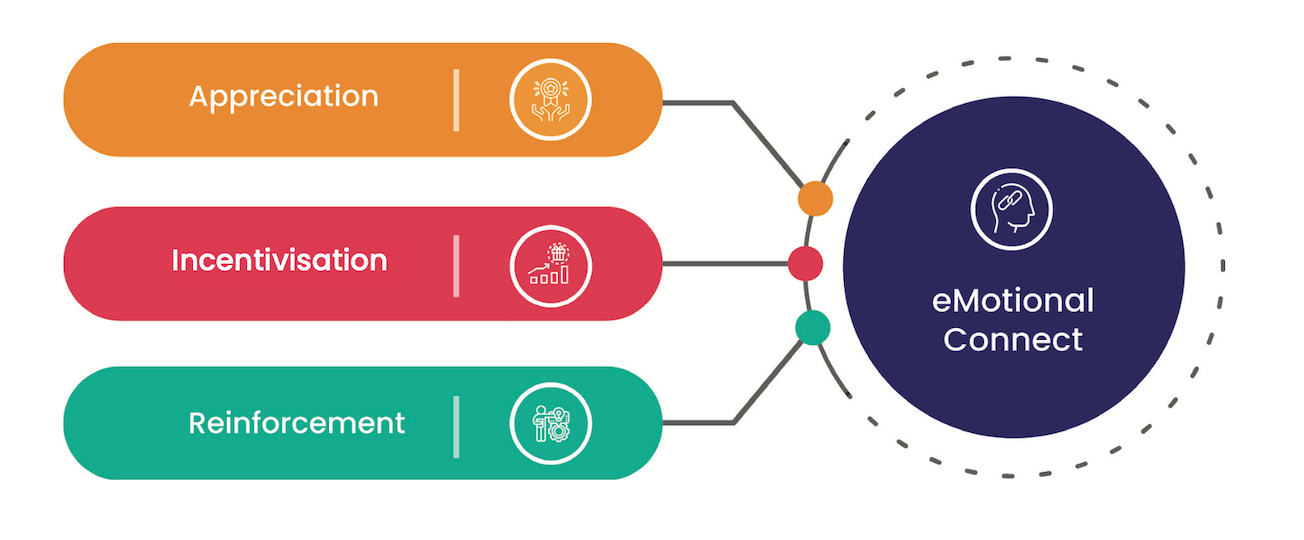How to Craft an Effective Employee Recognition Policy (Free Template)

A Global Employee Recognition and Wellness Platform
Imagine Lily, a hardworking employee who left no stone unturned to complete an ambitious project. She tackled the challenges and collaborated seamlessly with her team. Despite her efforts, she was not recognized, which in turn, dwindled her motivation.
Now, picture this: Lily’s efforts are celebrated immediately after the project’s completion. She receives a thank-you email, a team shout-out, and a personalized reward that shows her contributions matter. Her motivation and enthusiasm soars.
This is the true power of employee recognition. You see, a simple “Thank you” can go a long way. Having an employee recognition tool can transform the workplace for good.
A well-crafted employee recognition policy can guide the recognition process and help create a culture where every employee feels acknowledged, valued, and inspired to give their best.
In this blog, we’ll walk through how to create an effective recognition policy that creates a thriving and engaged workforce.
What is an Employee Recognition Policy?
An employee recognition policy is a structured approach that outlines how an organization will practice acknowledgment and reward employee contributions.
The policy defines the principles, guidelines, and processes for recognizing accomplishments that perfectly align with the company values.
A well-designed policy guarantees that recognition is consistent, fair, and meaningful, making employees feel appreciated, valued, and motivated.
Having said that, a recognition policy that sheds clarity about its recognition and rewarding practices has the potential to integrate recognition into daily routine and maintain its consistency.
Benefits of an Employee Recognition Policy

If you’re aiming to create a high-performing and thriving culture, having an employee recognition policy should be your primary responsibility. Here’s how a policy can benefit you in multiple ways:
1. Boost in Employee Engagement:
Recognition has always been a powerful driver of engagement. I do not claim this, but a statistic does.
According to a study, well-recognized employees are 7 times more likely to be fully engaged compared to those who are not recognized.
When employees feel appreciated, they’re inclined to give their best efforts, which adds to improved performance across the board.
2. Higher Retention Rates:
A Gallup research found that well-recognized employees are 45% less likely to change organizations after two years.
Recognition is a key contributor to retention. When employees realize how the organization is dedicated to acknowledging their efforts and accomplishments, they are inclined to stay longer.
Recognition helps you keep your top talent and reduce costly turnover.
3. Stronger Organizational Culture:
Recognition has the power to build an inclusive environment where everyone feels valued for their contributions.
This creates a cohesive culture that aligns with your organization’s mission and goals, thus strengthening your organizational culture.
4. Increased Productivity:
According to research, Employee recognition increases productivity by 17% when workers feel valued.
Recognition gives employees a sense of validation, making them more likely to take ownership of their work and strive for better outcomes.
As a result, it leads to higher productivity and improved performance for your business.
What are the Core Components of an Effective Employee Recognition Policy
The core components are the foundation of an effective employee recognition policy. Let’s explore them in detail below:
1. Clear Purpose and Goals
Every excellent recognition policy begins with a clear purpose. You need to state what you wish to achieve. Is it to improve performance, boost employee morale, or reinforce company values?
When you have a well-defined purpose, you can ensure that your recognition efforts aren’t just random but aligned with your company values and business goals.
Hence, set a clear purpose beforehand, such as increasing employee engagement, reducing turnover, or improving team collaboration, which will help you properly navigate your recognition efforts across your organization.
2. Eligibility and Inclusivity Criteria
Another core component is inclusivity. Every employee, irrespective of role, should be equally considered for recognition. This means that all the departments, functions, and remote teams are included in the recognition process.
Also, setting clear eligibility criteria helps employees understand how they can earn recognition, which encourages them to diversify their contributions.
Whether your employees work from the office, home, or a hybrid model, an excellent recognition policy ensures that nobody is left behind.
3. Recognizable Behaviors and Achievement Types
A good recognition policy identifies and states specific behaviors and achievements that deserve acknowledgment. Whether it's an employee going above and beyond their job description, assisting a team member succeed, or demonstrating leadership traits during a challenging situation, list them in the policy.
But do make sure that the behaviors you want to recognize are closely tied to your company values.
When employees get clarity on what actions are valued, they are inclined to embody those behaviors that not only give them value through recognition but also contribute to organizational success.
4. Types of Recognition: Formal, Informal, Peer-to-Peer, Managerial

Employees can be recognized in multiple forms, and the recognition system should be flexible enough to appeal to distinct personalities and preferences. Here are four significant types of recognition you can integrate into your policy:
-
Formal Recognition: These are structured forms of recognition that are often conferred in public. They include award ceremonies, bonuses, or employee of the month programs.
They create a sense of accomplishment and boost motivation among employees. -
Informal Recognition: These cover regular acts of appreciation, such as a thank-you email or a spontaneous shoutout in a meeting. These small gestures uplift employees as they feel seen and valued on a day-to-day basis.
-
Peer-to-Peer Recognition: Encouraging employees to recognize each other builds a culture of camaraderie and mutual respect. Peer-to-peer recognition programs help shape a more collaborative and supportive work environment.

Source: Vantage Recognition
- Managerial Recognition: In this form of recognition, managers take the lead in offering personalized acknowledgment.
Regular, one-on-one praise from leaders has the power to boost employee morale, which, in turn, maintains strong, positive relationships between managers and their teams.
5. Award Categories and Examples
Since awards are part and parcel of recognition and rewards, it is always best to have well-defined multiple award categories. This categorization can add variety to recognition and make it more meaningful for employees.
Here’s how you can craft awards that can acknowledge different types of excellence within your organization:
-
“Employee of the Month”: To celebrate employees for exceptional performance.
-
“Team Spirit Award”: To confer individuals or teams for demonstrating remarkable collaboration and teamwork.

Source: Vantage Recognition
-
“Innovation Excellence Award”: For creative problem solvers who introduce fresh ideas or drive change.
-
“Above and Beyond Award”: For employees who consistently go the extra mile.
In a way, you do not simply reward performance but promote vital values like collaboration, innovation, and creativity.
6. Recognizing Remote and Hybrid Employees
Recognition is equal for all employees, whether they work at the office, in a hybrid setting, or remotely. Definitely, when employees work outside the office, it becomes a little challenging to spot their contributions. However, they cannot be overlooked.
Given how technologically savvy workplaces have become, you can always opt for virtual platforms to keep your remote employees on pace with the office workers.
Virtual shoutouts, online awards, or remote team-building activities ensure that your recognition policy reaches everyone irrespective of location.
Recognizing remote workers publicly or through digital platforms keeps them engaged and connected to the larger team.
How to Design and Implement the Recognition Program
When designing and implementing the recognition program, it's crucial to highlight the key factors that ensure everyone understands how the program functions.
1. Defining Clear Roles and Responsibilities
To run a successful recognition program, you need to designate clear roles for managing and executing it. Make HR or a designated recognition team responsible for overseeing the program’s implementation and ensuring its consistency across the organization.
Also, define the responsibilities for tracking, awarding, and communicating recognition, and make it a seamless process.
2. Nomination and Selection Process: Fairness and Transparency
A transparent, fair nomination and selection process is the crux of building trust. Employees should be clear about how they can be nominated, what the criteria are, and how the winners are selected.
Clarity about the process leaves no scope for feelings of favoritism and will ensure that everyone adheres to the policy.
Recommended Resource: How to Nominate an Employee for Recognition: Criteria and Steps
3. Communication Plan: Promoting Awareness and Participation
A recognition program can only thrive when employees are aware of its existence and understand how to get involved. Therefore, consistent communication is key to driving awareness and participation.
Keep employees in the loop by regularly communicating the program’s process and benefits through various channels such as company newsletters, town halls, and internal portals.
Ensure the policy is visible, accessible, and well-understood by all to maximize participation.
4. Integration with Performance Management and Development Plans
To make sure that your recognition policy creates the maximum impact, you must integrate it with your performance management and employee development plans.
Recognizing employees for their performance not only rewards their contributions but also reinforces the behaviors and achievements your organization values most.
This ties recognition to long-term growth and reinforces the message that development and achievement are interlinked.
5. Leveraging Technology and Tools for Recognition
Today, technology is leading in making employee recognition engaging and scalable. Using recognition platforms like Vantage Recognition can streamline the recognition process by making it hassle-free, facilitating recognition in real-time
The tool can also automate rewards, track progress, and provide managers with the insights they need to ensure recognition is consistent across teams and departments.
Technology ensures that recognition integrates into the dynamic fabric of your company culture.
6. Use of Proper Framework

To ensure the recognition program you designed meets industry standards and is effective, consider using AIRe framework.
It is a methodology that helps design and evaluate employee recognition programs, focusing on maximizing the potential of recognition programs through the key themes:
Appreciation: Acknowledging the inherent worth or value of an employee or the behavior.
Incentivization: Making recognition attractive for employees who aspire to receive it.
Reinforcement: Guiding employees towards desired behaviors or results through recognition.
eMotional Connect: Attaching strong personal feelings to amplify the power of recognition.
Using this framework, you can undertake an AIRe assessment to get a qualitative assessment of your program design.
The assessment provides a design score, enabling companies to compare their score against the industry benchmark. This helps identify areas of strength and opportunities for improvement, ensuring your recognition becomes impactful.
Employee Recognition Policy Template
Here’s a template to assist you in crafting an effective employee recognition policy. Download the free template here.
Introduction:
At [Company Name], we are committed to cultivating a culture where employees feel valued and appreciated. Our employee recognition programs are designed to celebrate individual and team achievements, instill motivation, and build a company culture where everyone thrives.
Purpose:
The purpose of this policy is to establish a clear framework for managing and executing employee recognition programs at [Company Name]. With these guidelines in place, we aim to promote fairness, consistency, and transparency in recognizing the outstanding contributions of our employees, ensuring they are rewarded for their dedication and hard work.
Scope:
The policy applies to all employees of [Company Name], including full-time, part-time, and temporary staff. It outlines the process for recognition, including eligibility, nomination, and reward distribution, ensuring that all employees are given equal opportunity for acknowledgment.
Guidelines:
1. Eligibility Criteria:
- All employees, regardless of role, tenure, or employment type (full-time, part-time, temporary), are eligible for recognition.
- Recognition will be based on specific achievements, behaviors, or milestones that align with [Company Name's] values, mission, and strategic goals.
2. Nomination Process:
- Employees can be nominated for recognition by their peers, managers, or team leaders, ensuring a well-rounded acknowledgment of achievements.
- Nominations should be submitted through [insert platform or process for nominations], giving a brief description of the employee’s accomplishments and why they deserve recognition.
- Nominations will be reviewed periodically, considering the quality and impact of the achievements, as well as alignment with organizational values.
3. Criteria for selecting employees for Recognition
- Achieving Performance Targets: Employees are considered for recognition when they routinely meet or surpass their performance targets and goals.
- Leadership Skills: Employees demonstrating outstanding leadership qualities, such as inspiring and encouraging others, are recognized.
- Problem-solving skills: Employees are recognized for their remarkable problem-solving skills and for contributing creative solutions to problems.
- Innovation: Employees are recognized for thinking outside the box and introducing fresh ideas to drive change.
- Going Above and Beyond: Employees who continuously exceed their assigned tasks.
4. Types of Recognition:
- Formal Recognition: Includes awards, certificates, and public acknowledgment at company events or meetings.
- Informal Recognition: Spontaneous thank-you notes, shout-outs in meetings, or informal praise from colleagues and managers.
- Peer-to-Peer Recognition: Encourages employees to recognize each other’s contributions, cultivating a collaborative and supportive workplace.
- Managerial Recognition: Managers will regularly acknowledge their team members’ contributions through one-on-one praise, feedback, and personalized recognition.
5. Reward Distribution:
- Rewards for recognized employees include monetary bonuses, gift vouchers, additional paid time off, public acknowledgment, or other forms of meaningful rewards.
- The [insert department or individual responsible for managing rewards] will oversee the distribution of rewards, ensuring that all rewards are distributed fairly and promptly.
- Rewards will be tailored to suit the nature of the achievement, ensuring they are appropriate and aligned with the level of recognition.
6. Frequency and Communication:
- Employee recognition should be an ongoing part of company culture. Regular recognition, whether formal or informal, will ensure that employees feel continuously appreciated.
- A monthly or quarterly review of recognition nominations will help to ensure that employees' efforts are celebrated on time.
- Recognition will be communicated through multiple channels, including team meetings, newsletters, and company-wide emails, to ensure it reaches the entire organization.
7. Budget:
- Allocate a dedicated budget for recognition initiatives, including rewards, events, and tools.
- Specify how the budget will be used, covering both informal and formal recognitions.
- Ensure transparency and fairness in the distribution of funds to support all employees equally.
- Review the budget regularly to make sure it’s aligned with program goals and adjust as necessary for long-term success.
Conclusion
I’m sure you have gained clarity about crafting an effective employee recognition policy.
The next step is to apply this knowledge by creating a policy tailored to your company, helping you build a more engaging and thriving workplace.
FAQ
What is the reward and recognition policy document?
A reward and recognition policy is a formal document or set of guidelines established by an organization to acknowledge and appreciate the efforts and achievements of its employees.
What is the R&R policy in HR?
In Human Resources (HR), "R&R" typically stands for Rewards and Recognition. It refers to a system or policy within an organization that acknowledges and appreciates employees' contributions and achievements. This system can include both financial rewards (like bonuses or salary increases) and non-financial recognitions (like verbal praise or public acknoledgment).


















